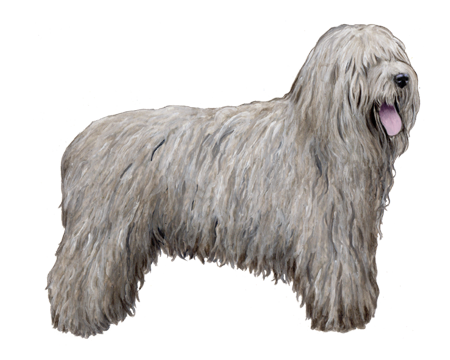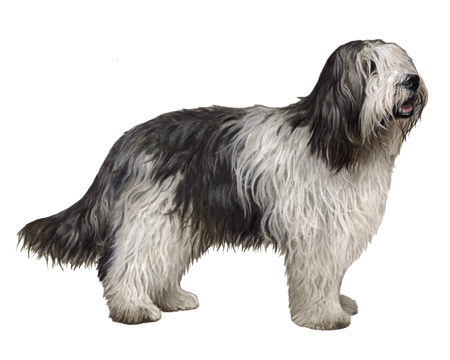
Belgian Malinois
The Belgian Malinois is a confident, intelligent working dog that takes pride in a job well done. Their strong protective instincts make Belgian Malinoises excellent guard dogs.
Interested in discovering if your dog is a Belgian Malinois?
Check out Wisdom Panel's DNA tests.

Belgian Malinois Traits
General Appearance
Belgian Malinoises are strong, agile, muscular dogs. Their bodies are similar in length and height and their topline, forelegs, and hind legs lend them a square appearance that adds to their well-balanced, elegant carriage.
Coat and Colouring
Belgian Malinoises have dense undercoats and short, straight overcoats with a texture that is hard enough to be weather resistant. Their hair is shorter on the head, ears, and lower legs, while longer around the neck, forming a collarette; the hair on their tails and backs of their thighs is longer, too.
Their coloring ranges from fawn to mahogany with black tips on the hair that give their coats the appearance of an overlay; their masks and ears are also black, while the undersides of their bodies, tail, and breaches are lighter fawn. In show, white is permitted on the tips of the toes and in a small area on the breastbone, not to extend to the neck.
Distinctive Physical Traits
These are working dogs with heavy bone structures, deep chests, short, strong loins, and muscular forequarters. Belgian Malinoises also have moderately pointed muzzles; triangular ears that are stiff and erect; and brown, medium-sized, almond-shaped eyes with an alert, attentive expression and an intelligent gaze.
Belgian Malinois Temperament
The right temperament is essential for this working breed. Belgian Malinoises are confident, protective, and reserved with strangers but not aggressive. With their owners, the breed is known for being affectionate, responsive to commands, and eager to please.
Belgian Malinoises have strong predatory instincts that can lead them to chase cars, children, and small animals. They are best suited to homes with older (or no) children and with well socialized dogs of similar size.


Belgian Malinois History
The Belgian Malinois hails from Malines, Belgium. The breed descended from local shepherd dogs and was first recognized in Belgium during the late 19th century.
Skilled herding dogs, Belgian Malinoises are the preferred breed for cattlemen and shepherds in their native land. In other countries, Belgian Malinoises are classified together with breeds like Laekenois, Tervuren, and Groenendael but have been registered as a separate breed in the United States since 1959.
A strong work ethic has made the Belgian Malinois popular for jobs off the farm; the dogs are often found working in military and police K9 units. A bronze statue of a Belgian Malinois at the Airborne and Special Operations Museum in Fayetteville, North Carolina, honors the dogs that have served in the line of duty since September 11, 2001.
Belgian Malinois Care
Nutrition
Feed Belgian Malinoises a high-quality dog food that is appropriate for their life stage (puppy, adult, senior) and consider a diet formulated for active breeds. Like other breeds, Belgian Malinoises could become overweight if their food intake is not monitored. Portion out their food with a standard measuring cup and limit treats to no more than 10% of their daily calories to avoid overfeeding.
Grooming
Belgian Malinoises have short, waterproof coats that are a snap to maintain. Brush them at least once per week to remove dead hair and reduce shedding. During semi-annual “shedding season” when the breed blows its coat, daily brushing and regular baths can help. Trim their nails to prevent cracking, splitting and painful overgrowths, and clean their ears. Regular dental care that includes at-home teeth brushing and professional cleanings is also an essential part of their grooming routines.
Exercise
These smart, active dogs require a lot of exercise. Belgian Malinoises love all activities, including hiking, running, and swimming and are tough competition in dog sports like agility, tracking, herding, and obedience. As long as they are burning off energy and spending time with their owners, Belgian Malinoises are happy. Due to their strong prey drive, these dogs might not make the best companions at the dog park.
Left alone for too long (or without enough exercise) Belgian Malinoises can develop behavior problems. In addition to high-intensity physical activity, provide mental stimulation with hide and seek, puzzle toys, or other interactive games.
Training
Training is a must for Belgian Malinoises. These dogs are intelligent and eager to learn new things; some might see training as a job and be enthusiastic students. Obedience training can help Belgian Malinoises control their herding instincts and socialization can encourage the breed to be more accepting of strangers and reduce fear-based aggression. Learning basic commands and new tricks also provides important mental stimulation.
Belgian Malinoises respond to consistent, firm training that prioritizes positive reinforcement and rewards-based training; the breed can be sensitive and does not appreciate harsh training methods.

Belgian Malinois Genetic Health Conditions
-
Cardiomyopathy and Juvenile Mortality (Discovered in the Belgian Shepherd)
Cardiomyopathy and Juvenile Mortality is an inherited condition associated with the death of young puppies following nonspecific signs of illness. The associated genetic variant has been identified in the Belgian Shepherd.
-
CNS Atrophy with Cerebellar Ataxia (Discovered in the Belgian Shepherd)
CNS Atrophy with Cerebellar Ataxia (CACA) is a neurological condition characterized by uncoordinated movements and intention tremors beginning at two weeks of age. The associated genetic variant has been identified in the Belgian Shepherd.
-
Hereditary Ataxia (Discovered in the Belgian Malinois)
Hereditary Ataxia is a neurologic disorder characterized by uncoordinated movements and partial paralysis of the hindlimbs. Signs usually first develop during puppyhood and are progressive. The associated genetic variant has been identified in the Belgian Malinois.
-
Hyperuricosuria
Hyperuricosuria (HUU) is a condition that predisposes affected dogs to the formation of urinary stones, such as kidney or bladder stones.
-
Spongy Degeneration with Cerebellar Ataxia (Discovered in Belgian Malinois - SDCA1)
Spongy Degeneration with Cerebellar Ataxia (SDCA) is an early onset disease of poor coordination, muscle twitching and seizures.
-
Spongy Degeneration with Cerebellar Ataxia (Discovered in Belgian Malinois - SDCA2)
Spongy Degeneration with Cerebellar Ataxia (SDCA2) is an early onset disease of loss of coordination, seizures, circling, and blindness.
Knowing if your Belgian Malinois is a carrier or at-risk for these conditions can help you and your veterinarian plan for your pup's lifelong care. With Wisdom Panel™ Premium, you can get results for over 200 genetic health tests.
Breed Group
Herding
The herding group is a diverse category. These highly intelligent breeds were developed to guard and control the movement of livestock.
Resources
https://www.akc.org/dog-breeds/belgian-malinois/
http://images.akc.org/pdf/breeds/standards/BelgianMalinois.pdf
Reviewed 26 July 2020 by Laura Inman, DVM

































































